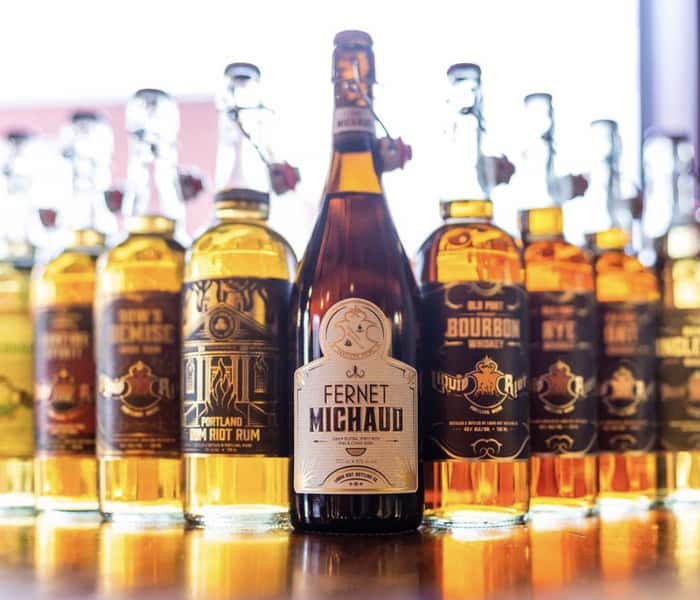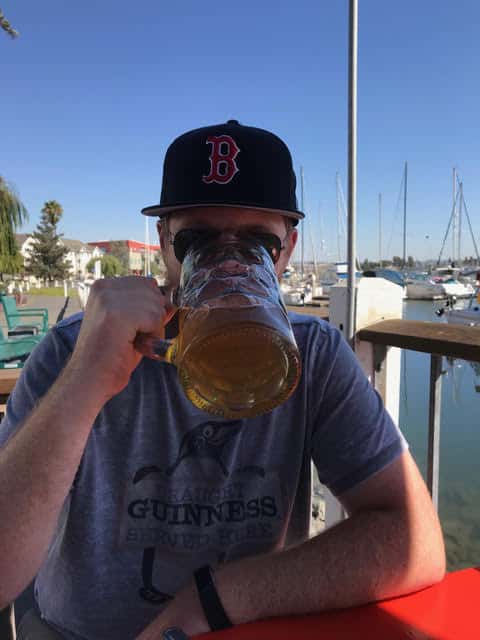
Many bars and restaurants offer a wide selection of alcoholic drinks, including beer, cider, wine, and spirits. While we’ve written extensively on exactly how to price your craft beer selection, finding the right price for your liquor drinks is a different game. Liquor prices that are too high could turn customers away while prices set too low could affect your bottom line. Because of this, a business owner needs to find a sweet spot in order to retain guests while simultaneously making a profit.
Mastering the pricing calculations of liquor drinks is an art because many factors go into determining the price, including how you serve your drinks, drink pour size, the competitors in your market, and your customer demographics. However, there’s also a science to pricing liquor drinks, and that’s what we’ll cover in this article.
What We’ll Cover in This Piece:
How Are You Serving Your Drinks?

Photography courtesy of Liquid Riot Bottling Company
Before pricing out your liquor drinks, you need to decide how you’ll be serving drinks. Are you focusing exclusively on cocktails? Or will you also offer options to enjoy certain spirits by themselves? While a standard menu usually includes a mix of some well-known cocktails, such as the Old Fashioned, margarita, Bloody Mary, and martini, many others offer spirits enjoyed neat or on the rocks.
If you have an extensive whiskey selection or well thought-out rum menu, don’t be afraid to show off those spirits alone. But, be aware that a pour on the rocks will increase the serving size of alcohol due to the volume of ice in the glass.
And, don’t forget that double pours could be a common request as well.
What Is a Pour Cost?
Exactly what it sounds like. To put it simply, a pour cost is what it costs your business to make a drink as a percentage of the price you sell it for. As an industry standard, most establishments set their pour costs between twenty to twenty-five percent.
The easiest way to regulate your pour cost is through how much liquor you have in each drink. This is also important to maintain the quality of the drinks, as well as flavor balance.
Typically, a standard pour size is 1 to 1.5 ounces of alcohol. So, if you adjust how much liquor you serve in a single drink, you can cover your drink costs without actually raising the price of a drink for the consumer.
How to Calculate the Price of Your Drinks

Photography courtesy of Patio29 Spirits Company
Calculating the price of your drinks involves the following steps:
- Determine the cost per ounce of your drink.
- Decide on your pour cost. The industry standard is between twenty to twenty-five percent. For our examples, we’ll stick with a twenty percent pour cost.
- Divide the cost per ounce by your pour cost.
Once you’ve established the types and size of drinks you’re serving, you need to figure out the cost per ounce. This will help you determine the final price. For the most part, you will be buying 25.4-ounce bottles. To find the cost per ounce, take the cost of the bottle and divide it by the ounces in the bottle. See below for an example with a $30 bottle.
- Cost of the bottle ÷ ounces in the bottle = cost per ounce.
- $30 ÷ 25.4 ounces = $1.18 per ounce
Your cost is $1.18 per ounce for that bottle.
Obviously, you need to sell it for more than that to make a profit. But how much more? For liquor, you’re looking for a pour cost between twenty to twenty-five percent. For this example, we will work with a twenty percent target for our pour cost. Keep in mind that this means the other eighty percent will be your profit margin on that pour.
We have our cost per ounce of $1.18. We know we want a twenty percent pour cost. Now we can calculate the drink price by taking the cost per ounce and dividing it by the pour cost.
- Cost per ounce ÷ pour cost = drink price
- $1.18 ÷ .20 = $5.90
Therefore, a drink that costs you $1.18 per ounce would sell at the bar for $5.90.
This is a pretty simple technique when it comes to liquor served by itself. Once you start adding in other ingredients you might need for specific cocktails, like simple syrup, mixers, and garnishes, you’ll need to factor in those costs as well.
For example, Bloody Mary mix involves several ingredients, as well as the time to make it (unless you buy pre-made). To figure out how much it costs to add a Bloody Mary mix or other ingredients to your drink such as mixers, garnishes, etc., use the price-per-ounce calculation.
Assuming you follow the industry standard of a twenty percent pour cost, with this method you can determine pretty quickly the strength of your beverage program and liquor revenues to your bottom line. If you are using a twenty percent pour cost and find that your drinks program is barely scraping by, perhaps it’s time to start moving more towards a fifteen percent pour cost.
Why Your Specific Market Is Important

Photography courtesy of Patio29 Spirits Company
At Liquid Riot Bottling Company in Portland, ME, which brews, distills, and has a full restaurant, Vice President of Operations Matthew Marrier says prices are ultimately determined based upon a number of costs. With a variety of expenses to cover, from rent and labor to utilities and insurance, tailoring menu prices to your business is the ultimate goal.
Depending on where you are in the country, or even your specific neighborhood within your city or town, the costs of doing business can vary widely. Once you know your baseline costs, you can move forward.
No matter where you’re located, you’ll likely have nearby competitors.
Industry competition is yet another factor to take into consideration when building your drinks program. If another bar across the street from you is selling margaritas for $10 while you sell them for $12, how might that impact your bottom line? Is your product superior and therefore worthy of a higher price? Are they possibly losing money by trying to undercut you? Or are they simply taking your business, meaning you need to reconsider pricing, advertising, or ingredients, even if it means you’re not hitting the pour costs we mentioned earlier?
Who Is Your Target Customer?
You need customers to patronize your business.
But, do you actually know who your customers are, or at least who you want them to be?
Knowing your audience is important because if you’re catering to a higher-end clientele you might be able to charge a bit more for, say, fancy cocktails. However, if you’re attracting more blue collar customers than you might want to stay on top of your craft beer pricing and even consider starting a happy hour.
What About Rare and Hyped Spirits?
If you are lucky enough to get your hands on an allotment of a rare or highly sought-after spirit, you’re then faced with the decision of how to price it. People are generally willing to pay more for higher quality products or a product they have no other way of tasting or acquiring.
In America, rare bourbon selections in particular have garnered a lot of attention lately. Phil DiCarlo, proprietor of Fenway Beer Shop, justifies higher prices on rare items like Blanton’s bourbons.
“This is because, one, there is far more demand than supply and they always sell out quickly regardless, [and] two, the customers that hunt these bourbons aren’t our regular customers; they come in, cherry-pick the Blanton’s, and leave.”
That leads DiCarlo to price such rare items at “higher-than-house margins,” where customers still see the value for the price they pay, and the store can make the most of their return without price gouging.
DiCarlo says that one Blanton’s product that they would typically sell for about $65 retail consistently flies off the shelf priced at $99. The trick is to find the right balance of financial return while keeping customers happy. If you try to push things past a reasonable limit, you’re going to make a lot of people angry.
Keep In Mind Your Local Liquor Laws

Photography courtesy of Patio29 Spirits Company
Whether you decide to keep prices as low as possible or stock as many high-end products as you can, always be aware that there are many restrictions when it comes to the sale of alcohol, including local, regional, state, and federal laws.
In some places, and depending on your business type and license, you may be limited on pour size, amount served per person per day, whether you can sell bottles to-go, how many bottles you can sell per person, whether you have to offer a food menu, and so on.
Continually check your local laws to make sure you’re staying compliant. Consult with an attorney for legal advice.
A Final Note
Whether you’re pouring dive-bar shots or high-end single malt, a homemade cocktail with the fanciest ingredients or a traditional Old Fashioned, dialing in how to price your liquor and drinks is a great way to boost your bottom line and keep your business flourishing.
Other Content You May Enjoy
To succeed and grow your restaurant, bar, or brewery you need to stand out in local search results. Whether someone is searching for the “best craft beer near me” or “top-rated seafood restaurant in [your city],” Local SEO (Search Engine Optimization) helps your business appear at the top of those search results.
With 81% of consumers using Google Search and Maps to find local businesses, and nearly 90% of customers choosing a business on the first page of search results, optimizing your online presence is essential.
This guide will walk you through Local SEO strategies tailored for restaurants, bars, and breweries, covering Google My Business, website optimization, online reviews, local backlinks, and more.
By the end of this guide, you’ll have a step-by-step action plan to increase your search rankings, attract more local customers, and grow your business.
In today’s digital world, having a well-designed, functional website is essential for restaurants, bars, and breweries. It goes beyond having social media. A great website can help attract new customers, showcase menus, accept reservations, and even drive online sales. But one of the most common questions business owners ask is: How much should a website cost in 2025?
The answer depends on several factors, including the type of website, features, complexity, and whether you choose a DIY solution or hire a professional web developer. Costs can range from a few hundred dollars for a basic website to tens of thousands for a fully customized, feature-rich platform.
This guide will break down website costs for restaurants, bars, and breweries, helping you understand the pricing landscape and choose the best solution for your business
Trivia nights have become an incredible marketing strategy for bars, restaurants, and breweries to draw in crowds and engage with new customers. With the recent collaboration between Geeks Who Drink, Timeplay, and the iconic television show Jeopardy!, businesses now have an exciting opportunity to host the Jeopardy! Bar League. This partnership combines the global brand recognition of Jeopardy! with Timeplay’s cutting-edge technology and the fun of live trivia from the experts at Geeks Who Drink.
In this piece we’ll cover what this new collaboration between these two trivia powerhouses is and how you can bring this unique experience to your venue.
In today’s world, both websites and social media platforms are crucial for a brewery, bar, or restaurant’s online presence. However, consumer habits show distinct preferences for each, depending on the context of their search or interaction.
In this guide, we’ll go over the basics, walk you through how to leverage these tools effectively, and show you how understanding these trends can help your venue better meet your customers’ expectations.
As a restaurant, bar, brewery, or any venue with a food and beverage program, having a modern, functional, and aesthetically pleasing website isn’t just a luxury—it’s a necessity.
No matter the size of your business, your new potential customers often interact with your website first—and first impressions matter.
In this piece, we’ll explore the top website trends shaping the online presence of hospitality businesses in 2025. These trends will help your venue stand out and attract more customers while creating a unique and modern experience to establish the perfect guest experience from start to finish.
For bar owners, hospitality managers, and small business owners, selecting the right gin brands is more than just filling the shelves—it’s about curating a distinctive customer experience. Gin has soared in popularity, becoming a staple of modern cocktail culture. With its complex botanical infusions, gin offers versatile, memorable flavors that can attract a wide range of customers. But with so many choices available, which brands should you prioritize to bring out the best in your gin menu?
This guide explores the seven best gin brands that have proven themselves through quality, craftsmanship, and unique flavor profiles. By understanding what makes each brand special, you and your staff will be better equipped to create a standout gin selection that delights your patrons, reinforces your brand’s reputation with a robust gin drinks menu, and helps you continue crafting classic and innovative gin cocktails.

